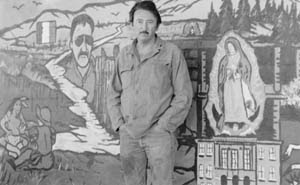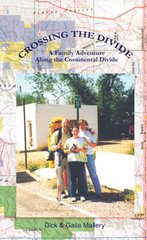
Read your post on the CDT List. Can you tell me a few things about the Great Divide Trail. I'm thinking of hiking it this year. Can I find stove alcohol along the way?
Here is my take on the GDT. It’s an incredible hike. I didn’t take any maps. I used Dustin’s book and it is all you need. You lose the trail occasionally and his GPS Coordinates will bring you back. Several times I had to bushwhack to get back to one of his points--no fun very thick tangles in some areas. The biggest problem is the clear cuts and that is where Dustin’s book is golden. Much of the Crown Land is heavily cut and log roaded. The people I talked to along the trail said it was because the Americans have such an appetite for their timber. A majority of the trail goes through protected areas.
The difference you will notice from the CDT is bigger water and more bears. I had two crossings I could not make at the trail proper--had to work up toward headwater to find a safe crossing-- and two Grizzly encounters. Fresh scat and mud prints are a very common sight. Let me give you a sure fire cure. I had a big male grizzly outside my Akto tent at Dutch Creek, which is Crown Land and heavily cut over.
No-see-ums were swarming about me en masse as I hung my food bag on the opposite side of the creek. On most nights I would sleep under my rain shelter only. With this horde of insects, I decided it would be wise to erect my tent inside the rain-fly if I wanted a good night’s sleep. I piled everything near the tent, threw it all inside, dove in myself and zipped the mesh door behind me.
It was fortunate that the bugs were menacing that evening, forcing me into the added protection of my fine-screened inner tent. I awoke suddenly in the early morning hours to a grunting sound outside my tent. With the fly open I had a clear view of a large male grizzly pacing back and forth, shaking his head and grunting as if he were irritated. Instead of grabbing my bear spray I grabbed my camera and completely opened the aperture in hopes of getting some pictures in the low light. I held it against the fine mesh tent wall and shot a roll of film. After exhausting the film I became concerned and started thinking about items that were still in my pack next to me in the tent vestibule. Fragrant things that should have been in the food bag, like baby wipes and toothpaste, were still in pack pockets and might be reason for this abrupt wake-up call. I decided it would be smart to subtly let the bear know I was in the tent, if he hadn’t figured it out already. I first cleared my throat. When that had no effect I coughed a couple times very loudly. The bear continued to pace and violently shake his head. What I did next could be better protection than bear spray. It worked so well I have had thoughts of sharing the procedure with the Forest Service. I took a deep breath and began to sing as loud as I could, "I’m in the mood for love. Simply because you’re near me. Funny but when you’re near me. I’m in the mood for love."
That bear went up the trail like a rocket leaving the Cape. He must have thought, "This guy not only smells bad, he’s horny." Never saw him again. The only other one I had to deal with personally was in the White Goat Wilderness. I do a lot of Robert Service poetry, especially "Bessie’s Boil" works as well if not better than my musical selections. I hiked in what the Canadians were calling "The Year of the Bear" so they may have stocked the area with more bruins for the celebration.
I use a zip ztove so know nothing about alcohol. I had no problem finding Crown Royal. In fact the last time I got a lot of heat (pun intended) from this list was when I said I used a zip ztove. Scathing posts about me using up endangered resources like ground litter--as if fueled stoves run on resources that have no impact.
I don’t want this to sound too much like my attitude on trespass, BUT--If you can stay on schedule from Waterton to Jasper your better packers than I. I told Dustin from the get-go that was impossible. He, of course, had to take the official stance that you pick your stops and stop at your picks but I think he realizes how impractical that is. I did the trail in 30 days, 21 of which were rain. I paid for my extended backcountry permit in Waterton (price has probably changed). I had to tell them every campsite I would use on each day. I did try hard to do that to keep myself on schedule. I had limited time. Unfortunately I never stayed in the right one once. Seldom found other hikers in any campsites (July 3rd to Aug 1st). Never found an occupied warden cabin.
The difference you will notice from the CDT is bigger water and more bears. I had two crossings I could not make at the trail proper--had to work up toward headwater to find a safe crossing-- and two Grizzly encounters. Fresh scat and mud prints are a very common sight. Let me give you a sure fire cure. I had a big male grizzly outside my Akto tent at Dutch Creek, which is Crown Land and heavily cut over.
No-see-ums were swarming about me en masse as I hung my food bag on the opposite side of the creek. On most nights I would sleep under my rain shelter only. With this horde of insects, I decided it would be wise to erect my tent inside the rain-fly if I wanted a good night’s sleep. I piled everything near the tent, threw it all inside, dove in myself and zipped the mesh door behind me.
It was fortunate that the bugs were menacing that evening, forcing me into the added protection of my fine-screened inner tent. I awoke suddenly in the early morning hours to a grunting sound outside my tent. With the fly open I had a clear view of a large male grizzly pacing back and forth, shaking his head and grunting as if he were irritated. Instead of grabbing my bear spray I grabbed my camera and completely opened the aperture in hopes of getting some pictures in the low light. I held it against the fine mesh tent wall and shot a roll of film. After exhausting the film I became concerned and started thinking about items that were still in my pack next to me in the tent vestibule. Fragrant things that should have been in the food bag, like baby wipes and toothpaste, were still in pack pockets and might be reason for this abrupt wake-up call. I decided it would be smart to subtly let the bear know I was in the tent, if he hadn’t figured it out already. I first cleared my throat. When that had no effect I coughed a couple times very loudly. The bear continued to pace and violently shake his head. What I did next could be better protection than bear spray. It worked so well I have had thoughts of sharing the procedure with the Forest Service. I took a deep breath and began to sing as loud as I could, "I’m in the mood for love. Simply because you’re near me. Funny but when you’re near me. I’m in the mood for love."
That bear went up the trail like a rocket leaving the Cape. He must have thought, "This guy not only smells bad, he’s horny." Never saw him again. The only other one I had to deal with personally was in the White Goat Wilderness. I do a lot of Robert Service poetry, especially "Bessie’s Boil" works as well if not better than my musical selections. I hiked in what the Canadians were calling "The Year of the Bear" so they may have stocked the area with more bruins for the celebration.
I use a zip ztove so know nothing about alcohol. I had no problem finding Crown Royal. In fact the last time I got a lot of heat (pun intended) from this list was when I said I used a zip ztove. Scathing posts about me using up endangered resources like ground litter--as if fueled stoves run on resources that have no impact.
I don’t want this to sound too much like my attitude on trespass, BUT--If you can stay on schedule from Waterton to Jasper your better packers than I. I told Dustin from the get-go that was impossible. He, of course, had to take the official stance that you pick your stops and stop at your picks but I think he realizes how impractical that is. I did the trail in 30 days, 21 of which were rain. I paid for my extended backcountry permit in Waterton (price has probably changed). I had to tell them every campsite I would use on each day. I did try hard to do that to keep myself on schedule. I had limited time. Unfortunately I never stayed in the right one once. Seldom found other hikers in any campsites (July 3rd to Aug 1st). Never found an occupied warden cabin.
Here are some high points (or maybe low points): Pages are from Dustin Lynx Book
1.I had problem at La Coulotte Peak, pg.24. Probably a stupid mistake on my part but I found it confusing. Ended up dropping into Castle River valley and walking through cold streams, game trails and logging roads to make it back to Castle Mtn. Ski Resort.
Mistake No. 2, pg. 76. was listening to a very nice fisherman who invited me to dinner. He said the last hiker he invited had been Chris Townsend. I would usually have gone but I was on a schedule. I hate that. Anyway he had seen a sow griz and two cubs near The Crown and told me I should go around. Once you leave Dustins trail info. you are on your own and its not fun. I ended up truly crawling through some thickets to get back on Dustins route past The Crown. Next time I would fight with a bear rather than listening to a generous fisherman.
Mistake No. 3 pg. 146 was trying to cross a small tributary at the very beginning of the David Thompson Heritage trail. The trail hasn’t been worked on since David went through. This is as close as I have ever come to getting seriously flushed into unforgiving water. I ended up finally going upstream just a ways and finding a very safe and easy crossing then dropping back down to the trail. More descriptive in the book.
When you reach the Howse River Delta pg. 160 just before The Crossing you will be better off staying on the main trail. Unless the water levels are down it would be painful to cross the many tribs to follow the Glacier Lake Trail. I tried several times because I’m not that smart. Follow the main trail all the way to Mistaya Canyon where you find a great foot bridge and it’s very scenic. The Saskatchewan River Crossing has restaurant, laundry, rooms. I can’t imagine they wouldn’t hold a package for you.
Overview: Good and well marked trail through parkland. Dustin’s book is very precise. I had few surprises. I can’t help you with food drops. Unlike most LDH’s I take my whole family with me when I go. Their job is to pick me up when I emerge and not spend too much money while I’m gone.
The Sunshine area was very distinctive. I never saw the lodge but the trail turned into a regular expressway through the ski area. I couple good shelters at Bryant Creek and Eygpt Lake. Bryant was empty but I didn’t stay there, Eygpt was packed to the gills and I did. Did I ever mention I hate shelters.
Leaving The Sas. River Crossing the trail becomes a compound angle. You follow a steep, rockysided streambed that climbs for several miles. The forest that border the stream is to thick to maneuver in. Slow going but well worth the price of admission once you reach the top. Then easy climbing.
Pinto Lake to Cataract Creek into the White Goat were confusing to me but I followed a tributary and finally hooked up again. If I had stayed on the main trail I think I would have found a junction but I got impatient and decided to play Daniel Boone again.
It’s is a wonderful trail. They call the Highway the Calendar Highway, the trail is much more magnificent.
Mistake No. 2, pg. 76. was listening to a very nice fisherman who invited me to dinner. He said the last hiker he invited had been Chris Townsend. I would usually have gone but I was on a schedule. I hate that. Anyway he had seen a sow griz and two cubs near The Crown and told me I should go around. Once you leave Dustins trail info. you are on your own and its not fun. I ended up truly crawling through some thickets to get back on Dustins route past The Crown. Next time I would fight with a bear rather than listening to a generous fisherman.
Mistake No. 3 pg. 146 was trying to cross a small tributary at the very beginning of the David Thompson Heritage trail. The trail hasn’t been worked on since David went through. This is as close as I have ever come to getting seriously flushed into unforgiving water. I ended up finally going upstream just a ways and finding a very safe and easy crossing then dropping back down to the trail. More descriptive in the book.
When you reach the Howse River Delta pg. 160 just before The Crossing you will be better off staying on the main trail. Unless the water levels are down it would be painful to cross the many tribs to follow the Glacier Lake Trail. I tried several times because I’m not that smart. Follow the main trail all the way to Mistaya Canyon where you find a great foot bridge and it’s very scenic. The Saskatchewan River Crossing has restaurant, laundry, rooms. I can’t imagine they wouldn’t hold a package for you.
Overview: Good and well marked trail through parkland. Dustin’s book is very precise. I had few surprises. I can’t help you with food drops. Unlike most LDH’s I take my whole family with me when I go. Their job is to pick me up when I emerge and not spend too much money while I’m gone.
The Sunshine area was very distinctive. I never saw the lodge but the trail turned into a regular expressway through the ski area. I couple good shelters at Bryant Creek and Eygpt Lake. Bryant was empty but I didn’t stay there, Eygpt was packed to the gills and I did. Did I ever mention I hate shelters.
Leaving The Sas. River Crossing the trail becomes a compound angle. You follow a steep, rockysided streambed that climbs for several miles. The forest that border the stream is to thick to maneuver in. Slow going but well worth the price of admission once you reach the top. Then easy climbing.
Pinto Lake to Cataract Creek into the White Goat were confusing to me but I followed a tributary and finally hooked up again. If I had stayed on the main trail I think I would have found a junction but I got impatient and decided to play Daniel Boone again.
It’s is a wonderful trail. They call the Highway the Calendar Highway, the trail is much more magnificent.
--Keep Smilin’, Dick E. Bird





















